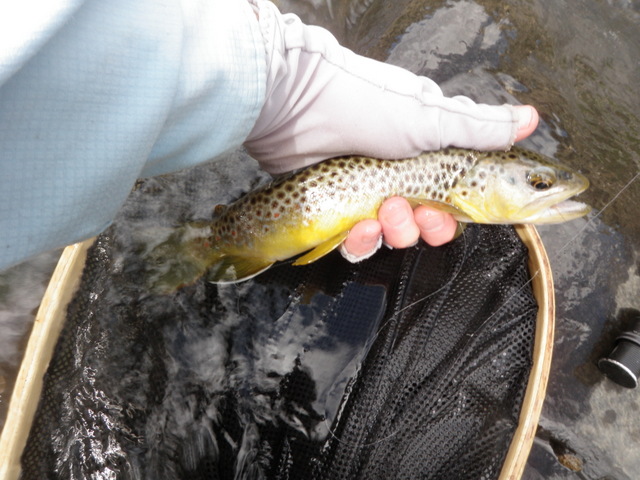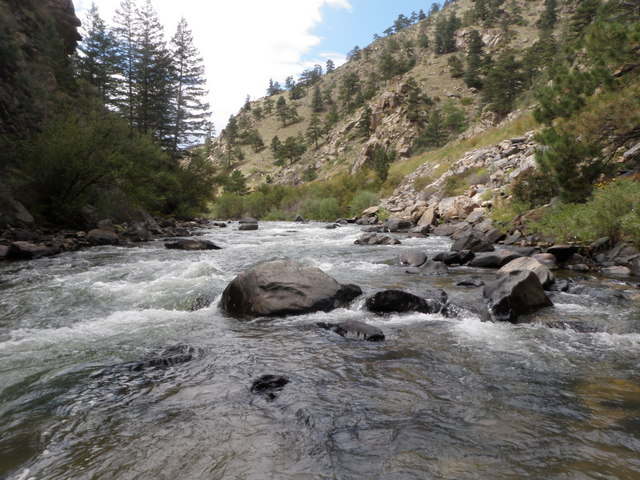Time: 11:30AM – 4:30PM
Location: After Tunnel 3 and before stream development area with signs about gold panning
Fish Landed: 13
Clear Creek 09/07/2014 Photo Album
After a spectacular day on Friday on the Arkansas River, I was seeking some easy nearby fishing. I had not fished in Clear Creek since a day very early in the season, and the flows had finally dropped to decent levels, so I decided to give the local stream a try. The DWR web site indicated that streamflows were at 100 CFS, and this level is in the ideal range. The weather was relatively nice with high temperatures forecast to reach the low 80’s with minimal chance of precipitation.
I took my time on Sunday morning as I knew I could make the drive to Clear Creek Canyon in less than an hour. Construction on the short tunnels at Idaho Springs made it difficult to fish in that stretch of water, so I began experimenting with fishing in Clear Creek Canyon west of Golden last year in the fall. I had one fairly productive day in the western end of the canyon near the point where the stream widens and stream improvements had taken place, so I targeted this as my destination. I was shocked to see most of the pullouts filled with cars as I drove along highway 6, but I did not observe many fishermen in the creek, so the owners of the vehicles must have been pursuing other recreational activities.
When I reached the stream improvement area, I did notice quite a few fishermen, so I executed a U-turn and drove east for a mile and parked along the shoulder above a steep bank. I prepared to fish and then hiked east along the shoulder of the busy highway for .3 miles to a point where the bank was not as intimidating. As I carefully negotiated the path to a break in the willows, I noticed some young kids ten yards below me in the shadow of some bushes next to the creek, so I angled to the west and found an opening. I decided to begin with a tan Charlie Boy hopper and beadhead hares ear and then added a copper john as the point fly. Unfortunately I discovered a difficult tangle in my line, and this stymied my enthusiasm for getting my flies on the water..
As I stewed over the tangle, I heard the sounds of clanking rocks, so I looked around the willows and noticed two young men dressed in waders. They didn’t have fishing rods, but they had a large five gallon plastic white bucket and appeared to be turning over rocks to collect bait or insects. Finally they moved upstream a bit and came into view, so I asked if they were fishing, and if I was in their path? They quickly responded that they were not fishing, and conversely they were panning for gold. I do not know much about this activity, but I never saw goldpanners turning over rocks, but I suppose there are different techniques involved in this popular recreational activity.
At any rate, they indicated that they did not plan to move upstream farther, so I refocused on my tangle and finally had my flies configured in a desirable manner and began to fish. My goal was to have a fun afternoon of mindless fishing that entailed catching a bunch of small fish on dry flies. The gorgeous pool above my starting point amazingly did not produce a single fish, so I should have taken this as an ominous sign. I continued above the pool and covered quite a bit of attractive water before I finally landed a small brown that attacked the Charlie Boy hopper. Shortly after this a ten inch brown slammed the Charlie Boy, and I landed a second fish. Unfortunately it took an hour of focused fishing, a lot of casting, and difficult wading to produce two relatively small fish.
I was convinced there were more fish than indicated by my fish totals, so I switched to a stimulator. This fly also produced two small browns, but the catch rate continued to be slow, and deep pools continued to be unproductive. In addition to the lack of rises or takes, I could see fish in several clear pockets that avoided my surface and subsurface flies.
At 1PM I adjourned for lunch and walked back to the car. I sat on the shoulder of the road and observed the stream below me. During this time I witnessed quite a few yellow sallies and a smattering of blue winged olives. I resolved to change my approach after lunch so when I returned to my exit point, I covered the lower end of a very attractive pool for a second time. This time, however, I returned to a dry/dropper approach with a Chernobyl ant, beadhead hares ear, and soft hackle emerger. Perhaps I should have started with my workhorse Chernobyl, and maybe the fish were looking for subsurface blue winged olive nymphs and emergers.
Once again my thought process was apparently flawed. I could not find the key to the supposedly naive Clear Creek brown trout. I landed one or two maverick fish that apparently did not get the message about my unappetizing flies, but much to my surprise, the soft hackle emerger wasn’t doing anything. I decided to remove it and replaced it with a salvation nymph. Finally I had a stretch where I landed three or four brown trout on the salvation particularly when I gave the flies a lift near the end of the drift. I thought I was on to something, but this short streak of action quickly ended, and I was back to covering large swaths of water for a few small fish.
I was getting frustrated and it was late afternoon when I approached a spot where there was a wide reach of slack water along the bank on the south shore directly across form me. A strong white water current ripped down the center of the creek, but I decided to try drifting my three flies through the slow moving water by holding my rod very high and keeping much of the fly line off the water. This did not produce, but as I was doing this, I spotted a fish hanging a foot below the surface obviously looking for food in the slow moving surface film. In fact it rose subtly and sipped while I was watching. Next I noticed a second fish a bit upstream and closer to the far bank, and this fish was exhibiting similar behavior.
I clipped off the trio of flies and tied on a yellow sally, as I saw a few stoneflies fluttering above the stream. I executed a nice cast and a quick mend and placed the stonefly above the fish that was furthest downstream. I held my breath as the visible fish slowly swam to the surface and put its nose against my fly, but it refused to gobble my offering. I tried for the upper fish which required a longer cast, and received a similar rejection. Could these fish be taking blue winged olive adults? I clipped off the yellow sally and tied on a size 20 CDC olive and began to cast to the lower fish. On the third cast the fish rose and sipped in my fly, and I quickly skipped it over the fast center current and netted it. It was quite gratifying to finally dupe an eight inch brown trout.
I continued casting to the upper fish, but my initial casts were not long enough, and out of nowhere a second brown jumped on the small BWO imitation. This fish also found a home in my net, and then I resumed making long reach casts to the upper fish. Unfortunately I could never interest this fish in my fly perhaps because I was generating instant drag. I decided to end my day on the positive note of landing two fish on a tiny dry fly. Easy fish that enabled me to pad my fish count was my goal. It did not play out that way. Fly fishing can be a contrarian pastime. When one expects easy fishing, it doesn’t happen, and red hot fishing can take place when one least expects it. Go figure.


